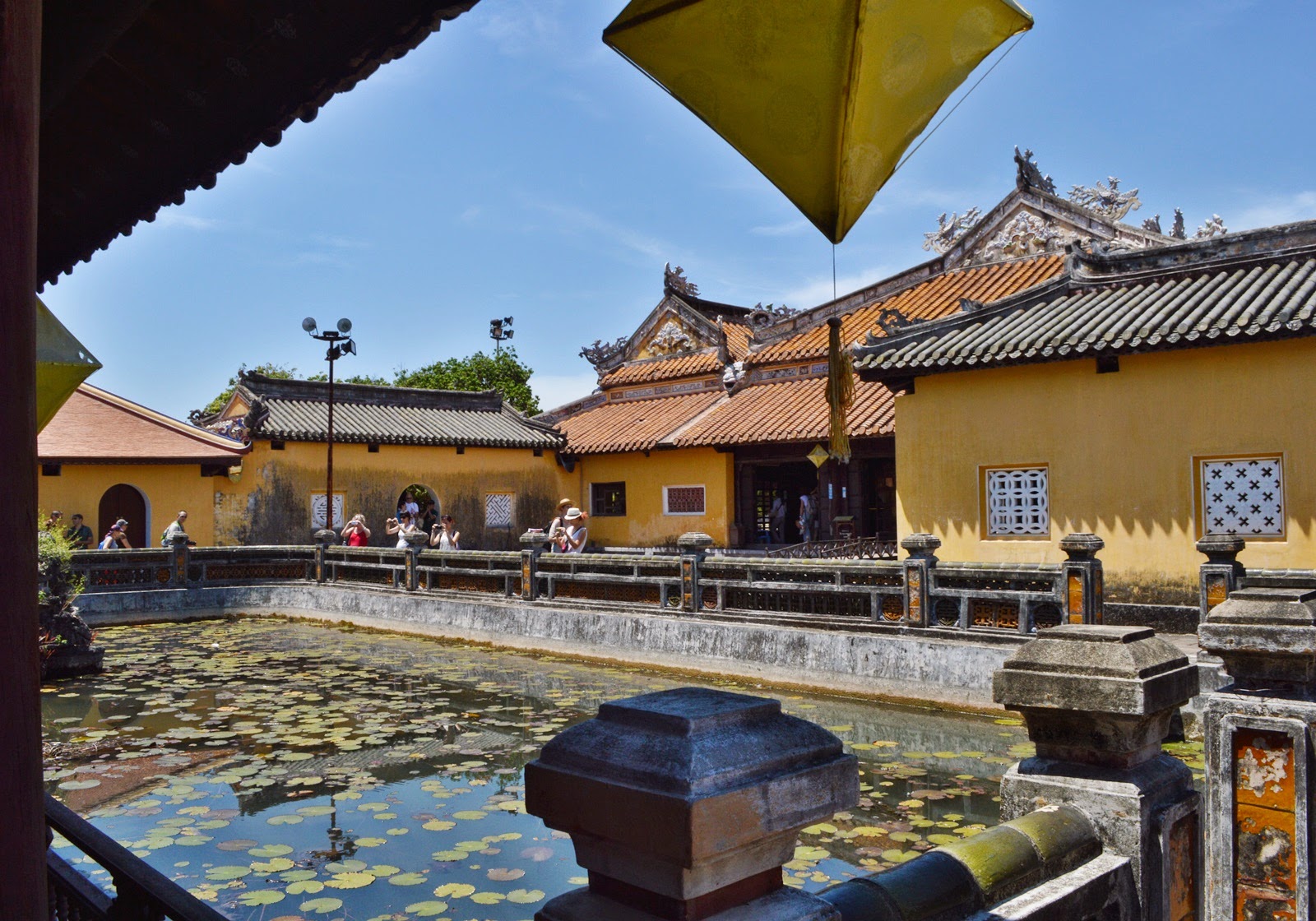
La siguiente parada no fue otra que Hue, la antigua capital imperial. Aquí nos encontramos con una ciudad llena de vida y el aroma de su río, el Perfume.
Solo por visitar el conjunto de monumentos declarados patrimonio de la Humanidad, vale la pena venir hasta aquí.
Penetramos al interior de la ciudadela , para toparnos con los restos de la Ciudad Imperial de Hue, echa a semejanza de la ciudad prohibida de Pekin, aquí llamada la Ciudad purpura prohibida. Durante una larga mañana recorrimos cada esquina y edificio en el interior de la ciudadela.
Pero Hue no sólo ofrece su patrimonio arquitectónico, sino que mas allá de las murallas se encuentra una ciudad alborotada, despierta que invita a recorrerla. Sobre todo pasear por los jardines a orillas del río Perfume mientras cae la tarde y probar su gastronomía debería ser obligatorio; sin olvidarnos de perder la vista siguiendo las embarcaciones en forma de dragón que recorren las aguas calmadas del río.
Por otro lado, no dejamos pasar la oportunidad de visitar el museo dedicado a Ho Chi Minh de Hue, sobre todo para seguir aprendiendo sobre la vida y obra del " Tío Ho". Aquí en Hue él pasó parte de su vida, estudiando y formándose.
 |
| on our way between Hoi An and Hue/ widoki po drodze między Hoi An i Hue/ las vista del camino entre Hoi An y Hue |
 |
| Ho Chi Minh Museum |
 |
| the extraoridinary sunset over Perfume river/ niezwykły zachód słońca nad rzeką Perfume/ una puesta de Sol extraordinaria sobre el río Perfume. |
 |
| violet ao dai- typical for Hue/ tradycyjny ubiór ao dai w kolorze fioletowym- typowym dla Hue/ típico de Hue; ao dai en color violeta. |
Hue is, along with Hoi An, another vietnamese site on the list of UNESCO's World Heritage. In the years between 1802 and 1945 it was the capital of the Nguyen dynasty imperium. The citadel, where the emperor had his seat is not as well maintained, as it should... the area is huge and some of the buildings were restored, but most of the site it is necesary to have a good imagination in order to see it's original beauty. The forbidden city was once a piece of art where only the emperor, his family, mistresses and close servants had access. Hue was definately worth visiting. Not only because of the citadel, but also for the great food (the best buddhist restaurant with mock meat that could deceive any meat eater!) and the most amazing, extraoridinary sunset over the Perfume river, that begun with rainbows and ended up with skies that looked like they were burning.
Szorcik: Podobnie jak Hoi An, również Hue zostało wpisane na listę zabytków UNESCO. Ruiny cytadeli w Hue nie są niestety tak dobrze zachowane, jak te w Hoi An, potrzebna jest tu miejscami dobra dawka wyobraźni, aby zwizualizować jak kiedyś mogło wyglądać to miejsce.
Hue to dawna stolica południowego Wietnamu- czyli królestwa Nguyen, rządzonego przez tę dynastię między rokiem 1802 a 1945. Ogromna cytadela mieściła w swoich murach zakazane miasto cesarza, do którego wstęp miały tylko najbliższe mu osoby: rodzina, współpracownicy, służący i nałożnice. Do tej pory szczęśliwie zachowały się małe fragmenty świadczące o dawnej świetności tego miejsca. Jedna Hue to nie tylko Cytadela. Znaleźliśmy to rewelacyjną buddyjską wegetariańską restaurację, gdzie urządzaliśmy sobie prawdziwe bankiety z potrawami naśladującymi mięso tak wiarygodnie, że udało nam się nabrać (co robi "szynka" w moim ryżu?). Matka natura też świetnie spisała się z okazji naszej wizyty ofiarowując nam najbardziej niesamowity, niepowtarzalny zachód słońca nad rzeką Perfume. Słoneczny spektakl zaczął się od chowających się za chmurami tęcz a skończył soczystą czerwienią przebijającą przez gęste chmury.
























No hay comentarios:
Publicar un comentario